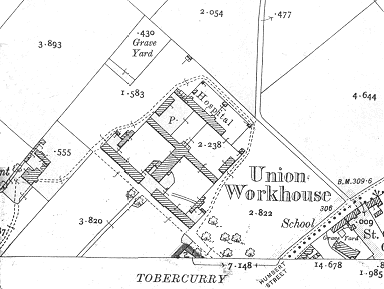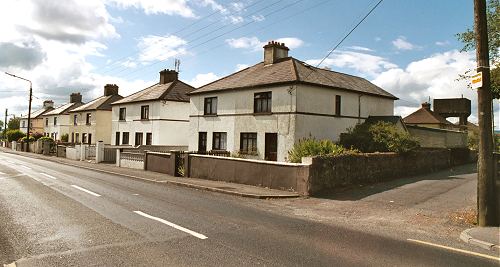Tubbercurry, Co. Sligo
Tubbercurry (or Tobercurry) was one of the new Poor Law Unions created in Ireland between 1848 and 1850. The new union was formally declared on 22nd February 1850. It was created from the northern part of the Swineford Union and the south-western part of the Sligo Union and occupied an area of 197 square miles. The population falling within the Tubbercurry Union at the 1901 census was 19,204. In 1905, it comprised the following electoral divisions:
Co. Sligo: East Achonry, West Achonry, Aclare, Annagh, Banada, Branchfield, Breencorragh, Carrownaskeagh, Cartron, Cloonacool, Cloonoghil, Coolaney, Glendarragh, Kilmacteige, Kilturra, Leitrim, Loughil, Owenmore, Streamstown, Temple, Tubbercurry.
The new Tubbercurry Union workhouse was erected in 1853 on a twelve-acre site at the north of Tubbercurry. Designed by the Poor Law Commissioners' architect George Wilkinson, the building was based on one of his standard plans to accommodate 500 inmates. Its construction cost £5,150 plus £1,220 for fittings etc. The site location and layout are shown on the 1913 OS map below.

Tubbercurry workhouse site, 1913.
The design was somewhat different to Wilkinson's earlier plans, and was a similar size and layout to workhouses such as those at Dromore West and Glenamaddy which were built at around the same time. The entrance at the south-west was flanked by two two-storey blocks which included school rooms and accommodation for boys and girls.
To the rear, the main buildings had a T-shaped layout. The central wing running southwards was probably a single-storey block containing the dining-hall and kitchens. To each side were accommodation wings for men and one for women. A hospital block lay at the north of the site, with the workhouse graveyard close by.
The workhouse buildings no longer exist and the Connolly Park housing estate now occupies the site.

Tubbercurry former workhouse site from the east, 2003.
© Peter Higginbotham.
Records
Note: many repositories impose a closure period of up to 100 years for records identifying individuals. Before travelling a long distance, always check that the records you want to consult will be available.
- Sligo County Library, Stephen Street, Sligo.
Bibliography
Links
- None.
Unless otherwise indicated, this page () is copyright Peter Higginbotham. Contents may not be reproduced without permission.


